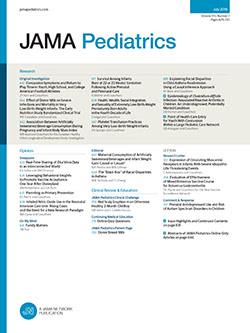美国各州的社会支出与早产和出生体重不足问题
IF 24.7
1区 医学
Q1 PEDIATRICS
引用次数: 0
摘要
重要性在美国,包括早产和出生体重不足在内的不良出生结果与社会经济劣势密切相关,对黑人母亲所生婴儿的影响尤为严重。增加对社会项目的投资是解决出生结果差异的一种潜在政策方法。目标研究州一级政府在社会项目上的支出与早产率和低出生体重率之间的关系,包括总体关系和种族关系。数据分析在 2022 年 5 月至 2024 年 5 月期间进行。暴露州和地方政府每年为每个低收入者在以下类别社会项目上的支出:州可退还所得税抵免;现金援助;儿童保育援助;住房和社区发展;以及公共卫生。主要结果和衡量标准每年州一级的早产率(胎龄<37周)和低出生体重率(<2500克)。结果从2011年1月1日到2019年12月31日,美国共有3510万活产婴儿,其中340万(9.8%)为早产儿,280万(8.1%)为低出生体重儿。每个低收入者的州社会支出中位数(IQR)为 1546 美元(1074-2323 美元)。州社会总支出越高,早产的总体比率越低(每个低收入者每增加 1000 美元的调整流行率 [aPR],0.99;95% CI,0.97-0.999),但与出生体重不足的总体比率无关。在二次分析中,州社会支出越多,黑人母亲的婴儿早产率越低(aPR,0.96;95% CI,0.92-0.999)。州政府在现金援助(aPR,0.64;95% CI,0.43-0.94)以及住房和社区发展(aPR,0.91;95% CI,0.84-0.98)方面的支出越多,黑人母亲的婴儿早产率越低。结论和相关性在这项横断面生态研究中,州政府在社会计划方面的支出越多,早产率就越低,尤其是黑人母亲的婴儿。州政府和地方政府可以考虑加强对现金援助、住房和社区发展的投资,以解决母婴健康差异问题。本文章由计算机程序翻译,如有差异,请以英文原文为准。
State Social Expenditures and Preterm Birth and Low Birth Weight in the US
ImportanceAdverse birth outcomes in the US, including preterm birth and low birth weight, are strongly tied to socioeconomic disadvantage and disproportionately impact infants of Black mothers. Increasing investments in social programs represents a potential policy approach to addressing disparities in birth outcomes.ObjectiveTo examine state-level associations of government expenditures on social programs with rates of preterm birth and low birth weight both overall and by race.Design, Setting, and ParticipantsThis cross-sectional, ecological study was conducted among liveborn infants in the 50 US states between January 1, 2011, and December 31, 2019. Data analysis was performed from May 2022 to May 2024.ExposuresYearly state and local government expenditures per low-income person on social programs in the following categories: state refundable Earned Income Tax Credit; cash assistance; childcare assistance; housing and community development; and public health.Main Outcomes and MeasuresYearly state-level rates of preterm birth (gestational age <37 weeks) and low birth weight (<2500 g).ResultsFrom January 1, 2011, to December 31, 2019, there were 35.1 million live births in the US, of which 3.4 million (9.8%) were preterm and 2.8 million (8.1%) were low birth weight. Median (IQR) state social expenditures per low-income person were $1546 ($1074-$2323). Greater total state social expenditures were associated with lower overall rates of preterm birth (adjusted prevalence ratio [aPR] for every increase of $1000 per low-income person, 0.99; 95% CI, 0.97-0.999) but not with overall rates of low birth weight. In secondary analyses, greater state social expenditures were associated with lower preterm birth rates for infants of Black mothers (aPR, 0.96; 95% CI, 0.92-0.999). Greater state expenditures specifically on cash assistance (aPR, 0.64; 95% CI, 0.43-0.94) and housing and community development (aPR, 0.91; 95% CI, 0.84-0.98) were associated with lower preterm birth rates for infants of Black mothers.Conclusions and RelevanceIn this cross-sectional, ecological study, greater state-level expenditures on social programs were associated with reduced rates of preterm birth, particularly for infants of Black mothers. State and local governments may consider bolstering investments in cash assistance and housing and community development to address maternal and infant health disparities.
求助全文
通过发布文献求助,成功后即可免费获取论文全文。
去求助
来源期刊

JAMA Pediatrics
PEDIATRICS-
CiteScore
31.60
自引率
1.90%
发文量
357
期刊介绍:
JAMA Pediatrics, the oldest continuously published pediatric journal in the US since 1911, is an international peer-reviewed publication and a part of the JAMA Network. Published weekly online and in 12 issues annually, it garners over 8.4 million article views and downloads yearly. All research articles become freely accessible online after 12 months without any author fees, and through the WHO's HINARI program, the online version is accessible to institutions in developing countries.
With a focus on advancing the health of infants, children, and adolescents, JAMA Pediatrics serves as a platform for discussing crucial issues and policies in child and adolescent health care. Leveraging the latest technology, it ensures timely access to information for its readers worldwide.
 求助内容:
求助内容: 应助结果提醒方式:
应助结果提醒方式:


